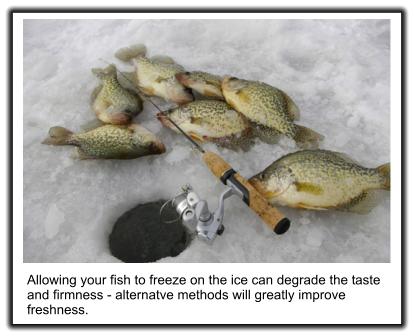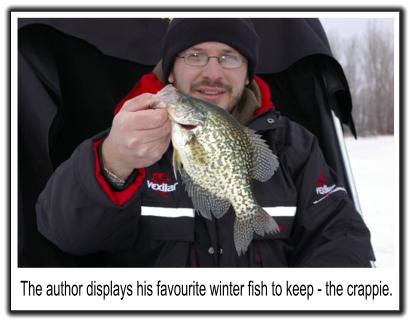"Keep Your Catch
Fresh When Working the Ice" Ice holds many wonders for those willing to auger through its outer crust. For some it is the lure of frantically running to an upright flag, unaware of the size of fish that tripped it below. Others find solace in the peace and serenity that a portable hut provides them on a snowy winters day. But if you're like me, the greatest treasure the ice conceals is the bountiful and tasty fish that swim beneath it, ready to be buttered and pan fried after a long day spent angling. For those looking for the optimum taste and freshness of your catch, give these tips a try the next time you hit the ice - your tummy will most certainly thank you! Fresh is Best But how you care for your catch from hook removal to home, can have an affect on the taste and condition that your dinner table fare will provide.
Although it is a common sight out on the ice, letting your catch freeze solid while lying at your feet can have a detrimental effect on its condition. Fish that freeze this way will often have burst muscle cells, due to expansion brought on from the extreme cold. Once they are thawed enough to fillet, the flesh will often lose some of its firmness or rigidity, which often leads to a less than perfect taste. Here are some great alternatives to freezing your fish on the ice. Bucket or Cooler The Stringer System We've all used a stringer sometime in our fishing career, and although utilizing one on ice may seem slightly strange, the fundamentals are one and the same. A long, thin rope is brought through the fishes' gill and mouth, after which both loose ends are brought together. Fish can now be lowered down beneath the ice, where they will stay alive and fresh while you continue to fish. It is imperative you tie off both loose ends on the surface of the ice, anchoring them down with a spike or other heavy object. We've all heard stories of the "one that got away," and an unsecured stringer is another way to add to this favourite fable. Homemade Livewell The premise is simple - drill a large number of holes side by side, paying careful attention not to bore through the bottom of the ice. These livewells can take on the shape of a square, rectangle or circle. Once you have constructed your well, a small hole is chipped through the ice, allowing water to rush in from the bottom and fill the remaining space. Fish keep well in these artificial enclosures, and will stay fresh and alive until days end. Fish you plan to release should not be kept in these wells, as the water temperature will become colder than normal, which may shock the fish and lead to death if let go. Again, please ensure that you mark these obstacles clearly when packing up for the day. Sticks with bright tape surrounding the hole are the best method. It goes without saying that an on-ice livewell isn't the best method for keeping fish when angling in a high traffic area. If using the stringer or livewell system, make sure you bring strong bags to transport your fish home in. Depending on my quarry, I prefer kitchen or medium sized garbage bags. And always double up, just in case of a rip or break. Give these methods a go when you hit the ice this season. Fresh fish is the best fish to bring to the table, and each of these is a proven winner.
|



 leaving
so unwary anglers don't step into these potential traps.)
leaving
so unwary anglers don't step into these potential traps.)